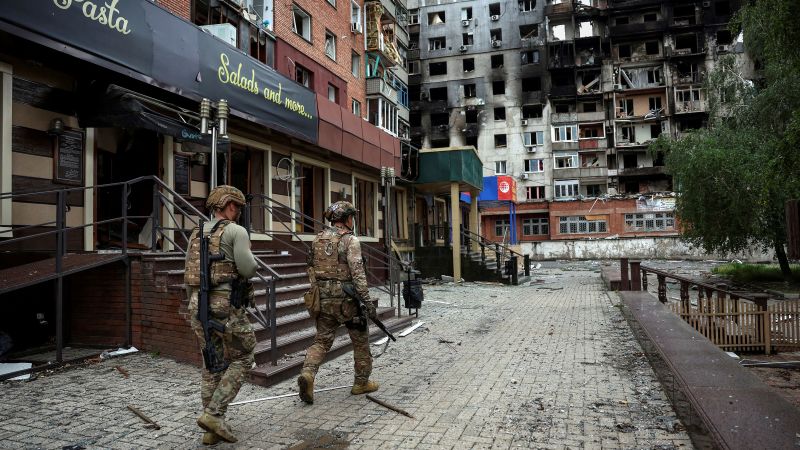
Russian forces are on the verge of capturing the eastern Ukrainian city of Pokrovsk, a significant victory that President Vladimir Putin has sought for nearly two years at a substantial cost. Recent days have seen intensified fighting within the city, with Russian troops reportedly having infiltrated its outskirts. While the strategic importance of Pokrovsk has diminished, its fall would mark Moscow’s most substantial success since 2023, indicating a shift in the conflict’s dynamics.
Despite Russian claims of encircling Ukrainian forces in Pokrovsk, Kyiv has denied these assertions. Ukrainian officials stated that military operations to halt the Russian advance are ongoing. However, soldiers on the ground have painted a grim picture of their circumstances. A battalion commander, who requested anonymity for security reasons, described the conflict as challenging, with urban firefights and widespread shelling. “We are almost surrounded, but we are used to it,” he noted.
Another soldier from the Ukrainian Peaky Blinders drone unit explained the Russian military’s tactics. He stated, “The intensity of their movements is so great that our drone operators cannot keep up with the pace. The Russians often move in groups of three, counting on the fact that two will be destroyed, but one will still reach the city.” He reported that around a hundred such groups can advance in a single day.
A Shift from Strategic Value to Symbolism
The situation in Pokrovsk has evolved into a battle of symbolism rather than a fight for a strategically vital location. According to George Barros, who leads the Russia and Geospatial Intelligence teams at the Institute for the Study of War, the high number of Russian casualties around Pokrovsk underscores the illogical nature of the conflict. “From a battlefield perspective, it doesn’t make sense,” he asserted.
Historically, Pokrovsk was crucial for Ukraine due to its road and rail connections, serving as a supply line that supported operations in the surrounding areas. However, as Russia began encircling the city over the summer, frequent drone and artillery attacks disrupted these logistics, forcing Ukraine to seek alternative routes.
The city also housed Ukraine’s last operational coking coal mine, which ceased operations early this year. Barros emphasized that the capture of Pokrovsk, while symbolically significant, offers little operational advantage to Russia as they have already achieved their primary objective.
Ukrainian President Volodymyr Zelensky recently stated that Russia has amassed approximately 170,000 troops in the region to bolster the offensive on Pokrovsk. Although the city’s strategic value has diminished, it remains a potent symbol in a war that has largely stagnated. If captured, Pokrovsk would represent the largest city seized by Russia since Bakhmut in May 2023.
Before the conflict, Pokrovsk had a population of around 60,000, but many residents have evacuated due to the ongoing crisis. Current estimates suggest that about 1,200 civilians remain, with some unable to leave and others possibly waiting for the arrival of Russian forces. The Russian Ministry of Defense has released videos purportedly showing the evacuation of Pokrovsk residents to the Russian side.
The Political and Strategic Implications
Strategically, the capture of Pokrovsk would enable Russia to redirect its focus to other industrial cities to the northeast, which are vital to Ukrainian defenses. One soldier from Ukraine’s 129th Brigade, stationed near Kostyantynivka, expressed concerns regarding the implications of a Russian victory in Pokrovsk. “As soon as the Russians deal with Pokrovsk and the neighboring town of Myrnohrad, the pressure on Kostyantynivka will increase,” he said.
Despite facing shortages in personnel and armored vehicles, the Ukrainian battalion is under pressure to maintain control of Pokrovsk. The soldier voiced fears that the Ukrainian leadership may hesitate to withdraw, as abandoning the city would be perceived as a significant failure. “There has been no order to withdraw, although everyone understands that the fall of Pokrovsk is inevitable,” he remarked.
The soldier recounted previous experiences, noting the dangers of delayed withdrawals. The battles for Bakhmut in 2023 and Avdiivka in 2024 were marked by high casualty rates due to similar hesitations. “We will have to squeeze through the bottleneck, and you surely understand the high level of losses that such an exit from the encirclement will entail,” he concluded.
As the situation in Pokrovsk continues to unfold, its outcome will likely have significant implications for both the strategic landscape of the conflict and the morale of the forces involved. The ongoing battle underscores the complexities of modern warfare, where symbolic victories can carry as much weight as strategic ones.





